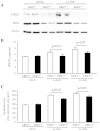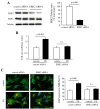Targeted deletion of ERK2 in cardiomyocytes attenuates hypertrophic response but provokes pathological stress induced cardiac dysfunction
- PMID: 24631771
- PMCID: PMC4046245
- DOI: 10.1016/j.yjmcc.2014.03.002
Targeted deletion of ERK2 in cardiomyocytes attenuates hypertrophic response but provokes pathological stress induced cardiac dysfunction
Abstract
Mitogen-activated protein kinases (MAPKs) are involved in the regulation of cardiac hypertrophy and myocyte survival. Extracellular signal regulated protein kinase 1 and 2 (ERK1/2) are key components in the MAPK signaling pathways. Dysfunction of ERK1/2 in congenital heart diseases (Noonan syndrome and LEOPARD syndrome) leads to cardiac hypertrophy. ERK2 contributes 70% of protein content to total ERK1/2 content in myocardium; however, the specific role of ERK2 in regulating cardiac hypertrophy is yet to be further defined. To investigate the specific role of ERK2 played in the cardiomyocytes, we generated and examined mice with cardiomyocyte-specific deletion of the erk2 gene (ERK2(cko) mice). Following short-term pathological hypertrophic stresses, the mutant mice showed attenuated hypertrophic remodeling characterized by a blunted increase in the cross-sectional area of individual myocytes, downregulation of hypertrophic foetal gene markers (ANP and BNP), and less interstitial fibrosis. However, increased cardiomyocyte apoptosis was observed. Upon prolonged stimulation, ERK2(cko) mice developed deterioration in cardiac function. However, absence of ERK2 did not affect physiological hypertrophy induced by 4weeks of swimming exercise. These results revealed an essential role for ERK2 in cardiomyocytes in the development of pathological hypertrophic remodeling and resistance to cell death.
Keywords: Apoptosis; Cardiac hypertrophy; Genetically modified mice; Interstitial fibrosis; Signal transduction.
Crown Copyright © 2014. Published by Elsevier Ltd. All rights reserved.
Figures











References
-
- Hill J.A., Olson E.N. Cardiac plasticity. N Engl J Med. 2008;358:1370–1380. - PubMed
-
- Maron B.J. Hypertrophic cardiomyopathy in childhood. Pediatr Clin North Am. 2004;51:1305–1346. - PubMed
-
- Ogata T., Yoshida R. PTPN11 mutations and genotype-phenotype correlations in Noonan and LEOPARD syndromes. Pediatr Endocrinol Rev. 2005;2:669–674. - PubMed
-
- Burch M., Sharland M., Shinebourne E., Smith G., Patton M., McKenna W. Cardiologic abnormalities in Noonan syndrome: phenotypic diagnosis and echocardiographic assessment of 118 patients. J Am Coll Cardiol. 1993;22:1189–1192. - PubMed
-
- Tartaglia M., Mehler E.L., Goldberg R., Zampino G., Brunner H.G., Kremer H. Mutations in PTPN11, encoding the protein tyrosine phosphatase SHP-2, cause Noonan syndrome. Nat Genet. 2001;29:465–468. - PubMed
Publication types
MeSH terms
Substances
Grants and funding
LinkOut - more resources
Full Text Sources
Other Literature Sources
Molecular Biology Databases
Miscellaneous

